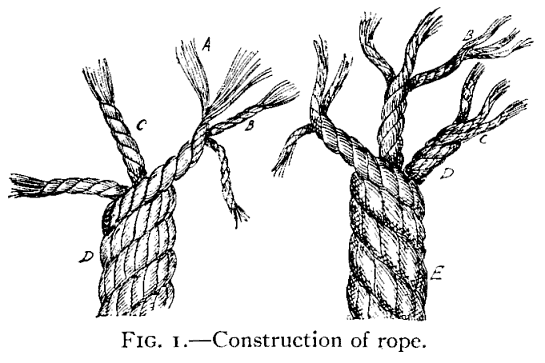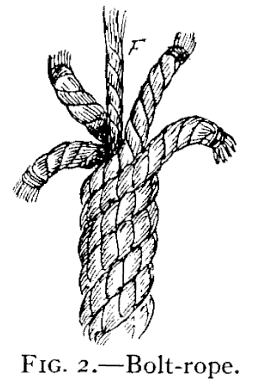Knots, Splices and Rope Work, by A. Hyatt Verrill
Chapter 1 - Cordage
CONTENTS
- Cover
- Introduction
- Chapter 1 - Cordage
- Chapter 2 - Simple Knots And Bends
- Chapter 3 - Ties And Hitches
- Chapter 4 - Nooses, Loops, And Mooring Knots
- Chapter 5 - Shortenings, Grommets, And Selvagees
- Chapter 6 - Lashings, Seizings, Splices, Etc.
- Chapter 7 - Fancy Knots And Rope Work
CORDAGE
Before taking up the matter of knots and splices in detail it may be well to give attention to cordage in general. Cordage, in its broadest sense, includes all forms and kinds of rope, string, twine, cable, etc., formed of braided or twisted strands.

In making a rope or line the fibres (A, Fig. 1) of hemp, jute, cotton, or other material are loosely twisted together to form what is technically known as a "yarn" (B, Fig. 1). When two or more yarns are twisted together they form a "strand" (C, Fig. 1). Three or more strands form a rope (D, Fig. 1), and three ropes form a cable (E, Fig. 1). To form a strand the yarns are twisted together in the opposite direction from that in which the original fibres were twisted; to form a rope the strands are twisted in the opposite direction from the yarns of the strands, and to form a cable each rope is twisted opposite from the twist of the strands. In this way the natural tendency for each yarn, strand, or rope to untwist serves to bind or hold the whole firmly together (Fig. 1).

Rope is usually three-stranded and the strands turn from left to right or "with the sun," while cable is left-handed or twisted "against the sun" (E, Fig. 1). Certain ropes, such as "bolt-rope" and most cables, are laid around a "core" (F, Fig. 2) or central strand and in many cases are four-stranded (Fig. 2).
The strength of a rope depends largely upon the strength and length of the fibres from which it is made, but the amount each yarn and strand is twisted, as well as the method used in bleaching or preparing the fibres, has much to do with the strength of the finished line.
Roughly, the strength of ropes may be calculated by multiplying the circumference of the rope in inches by itself and the fifth part of the product will be the number of tons the rope will sustain. For example, if the rope is 5 inches in circumference, 5 X 5 = 25, one-fifth of which is 5, the number of tons that can safely be carried on a 5-inch rope. To ascertain the weight of ordinary "right hand" rope, multiply the circumference in inches by itself and multiply, the result by the length of rope in fathoms and divide the product by 3.75. For example, to find the weight of a 5-inch rope, 50 fathoms in length: 5 X 5 = 25; 25 x 50 = 1,250; 1,250 / 3.75 = 333-1/3 lbs. These figures apply to Manila or hemp rope, which is the kind commonly used, but jute, sisal-flax, grass, and silk are also used considerably. Cotton rope is seldom used save for small hand-lines, clothes-lines, twine, etc., while wire rope is largely used nowadays for rigging vessels, derricks, winches, etc., but as splicing wire rope is different from the method employed in fibre rope, and as knots have no place in wire rigging, we will not consider it.
NOTICE: Some pages have affiliate links to Amazon. As an Amazon Associate, I earn from qualifying purchases. Please read website Cookie, Privacy, and Disclamers by clicking HERE. To contact me click HERE. For my YouTube page click HERE